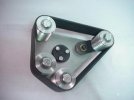- Joined
- Jan 10, 2015
- Messages
- 1,673
Forgive the quote out of place, but this question just didn't seem to belong in the for sale arena.
Nathan, or anyone really,
I wanted to ask if you've ever considered running a rubber belt under the grit belt, but over the radius platen. Something like Beaumont's rotary platen attachment:

I'm not sure how it would affect cooling or platen wear, but as far as grinding, it seems it would act more like a true wheel. Thoughts?
Radius platens simulate large wheels. They're called a "radius platen" because they're machined with a radius. The size number references the size wheel they simulate. So a 36" radius platen actualy has an 18" radius. It simulates a 36" diameter wheel.

In using the radius platens I have found the effect is subtle, but noticeable. It isn't a flat grind, but it isn't really a hollow grind. I believe this is a historically accurate grind for blades ground in yesteryear on really big stones. I see this being a cool grind for blades made in an older style, and blades like kitchen knives where you would want a full height grind on a tall thin blade.
The A2 is quality steel from Latrobe, heat treated at Peter's Heat Treat with cryo and is harder than a woodpecker's lips. But it can still wear out quickly if exposed to certain grinding conditions that cause grinding grit to accumulate on the inside of your belt and cut the platen. Some belts have dry lubricants, coolant and other "aids" that work great on a contact wheel but can cause black gunk buildup on the inside of the belt that can then cut the platen, particularly when they get hot or damp. If you're getting black buildup on your platen beware of cutting grooves.
Unlike a flat platen that you can re flatten, a worn out radius platen is toast. You can extend the life of your platen by not using it to rough or profile. If you establish your grind on a regular flat platen or wheel and if you'll avoid cutting it with grinding grit your radius platen will develop a mirror finish and can grind hundreds of knives over its life before developing troublesome wear.
You will probably want a platen chiller if you're using a radius platen, particularly the 36" and 48".
Nathan, or anyone really,
I wanted to ask if you've ever considered running a rubber belt under the grit belt, but over the radius platen. Something like Beaumont's rotary platen attachment:

I'm not sure how it would affect cooling or platen wear, but as far as grinding, it seems it would act more like a true wheel. Thoughts?
Last edited:
